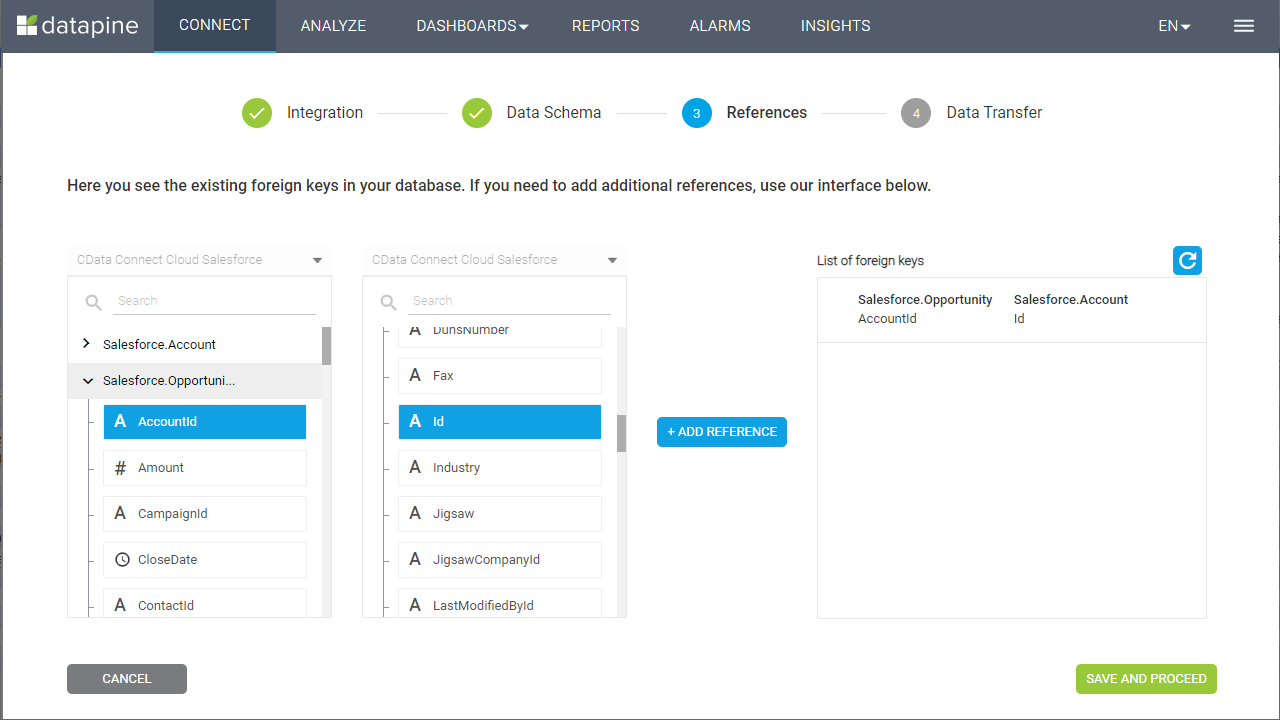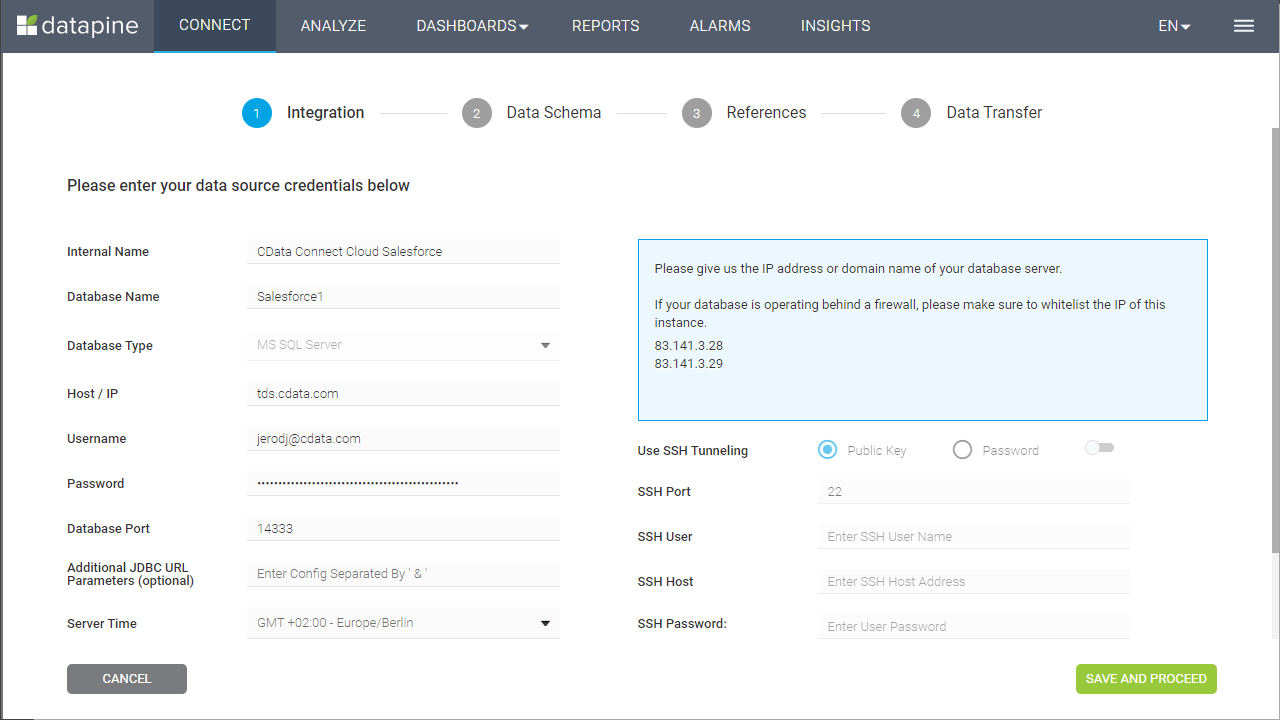Model Context Protocol (MCP) finally gives AI models a way to access the business data needed to make them really useful at work. CData MCP Servers have the depth and performance to make sure AI has access to all of the answers.
Try them now for free →Build Odoo-Connected Visualizations in datapine
Use CData Connect Cloud and datapine to build visualizations and dashboards with access to live Odoo data.
datapine is a browser-based business intelligence platform. When paired with the CData Connect Cloud, you get access to your Odoo data directly from your datapine visualizations and dashboards. This article describes connecting to Odoo in CData Connect Cloud and building a simple Odoo-connected visualization in datapine.
CData Connect Cloud provides a pure SQL Server interface for Odoo, allowing you to query data from Odoo without replicating the data to a natively supported database. Using optimized data processing out of the box, CData Connect Cloud pushes all supported SQL operations (filters, JOINs, etc.) directly to Odoo, leveraging server-side processing to return the requested Odoo data quickly.
About Odoo Data Integration
Accessing and integrating live data from Odoo has never been easier with CData. Customers rely on CData connectivity to:
- Access live data from both Odoo API 8.0+ and Odoo.sh Cloud ERP.
-
Extend the native Odoo features with intelligent handling of many-to-one, one-to-many, and many-to-many data properties. CData's connectivity solutions also intelligently handle complex data properties within Odoo. In addition to columns with simple values like text and dates, there are also columns that contain multiple values on each row. The driver decodes these kinds of values differently, depending upon the type of column the value comes from:
- Many-to-one columns are references to a single row within another model. Within CData solutions, many-to-one columns are represented as integers, whose value is the ID to which they refer in the other model.
- Many-to-many columns are references to many rows within another model. Within CData solutions, many-to-many columns are represented as text containing a comma-separated list of integers. Each value in that list is the ID of a row that is being referenced.
- One-to-many columns are references to many rows within another model - they are similar to many-to-many columns (comma-separated lists of integers), except that each row in the referenced model must belong to only one in the main model.
- Use SQL stored procedures to call server-side RFCs within Odoo.
Users frequently integrate Odoo with analytics tools such as Power BI and Qlik Sense, and leverage our tools to replicate Odoo data to databases or data warehouses.
Getting Started
Configure Odoo Connectivity for datapine
Connectivity to Odoo from datapine is made possible through CData Connect Cloud. To work with Odoo data from datapine, we start by creating and configuring a Odoo connection.
- Log into Connect Cloud, click Connections and click Add Connection
- Select "Odoo" from the Add Connection panel
-
Enter the necessary authentication properties to connect to Odoo.
To connect, set the Url to a valid Odoo site, User and Password to the connection details of the user you are connecting with, and Database to the Odoo database.
![Configuring a connection (Salesforce is shown)]()
- Click Create & Test
-
Navigate to the Permissions tab in the Add Odoo Connection page and update the User-based permissions.
![Updating permissions]()


Add a Personal Access Token
If you are connecting from a service, application, platform, or framework that does not support OAuth authentication, you can create a Personal Access Token (PAT) to use for authentication. Best practices would dictate that you create a separate PAT for each service, to maintain granularity of access.
- Click on your username at the top right of the Connect Cloud app and click User Profile.
- On the User Profile page, scroll down to the Personal Access Tokens section and click Create PAT.
- Give your PAT a name and click Create.
- The personal access token is only visible at creation, so be sure to copy it and store it securely for future use.

Connecting to Odoo from datapine
Once you configure your connection to Odoo in Connect Cloud, you are ready to connect to Odoo from datapine.
- Log into datapine
- Click Connect to navigate to the "Connect" page
- Select MS SQL Server as the data source
- In the Integration step, fill in the connection properties and click "Save and Proceed"
- Set the Internal Name
- Set Database Name to the name of the connection we just configured (e.g. Odoo1)
- Set Host / IP to "tds.cdata.com"
- Set Username to your Connect Cloud username (e.g. user@mydomain.com)
- Set Password to the corresponding PAT
- Set Database Port to "14333"
![Configuring the connection to CData Connect Cloud]()
- In the Data Schema step, select the tables and fields to visualize and click "Save and Proceed"
![Selecting tables and fields to visualize (Salesforce is shown)]()
- In the References step, define any relationships between your selected tables and click "Save and Proceed"
![Defining foreign key relationships]()
- In the Data Transfer step, click "Go to Analyzer"
Visualize Odoo Data in datapine
After connecting to CData Connect Cloud, you are ready to visualize your Odoo data in datapine. Simply select the dimensions and measures you wish to visualize!

Having connect to Odoo from datapine, you are now able to visualize and analyze real-time Odoo data no matter where you are. To get live data access to 100+ SaaS, Big Data, and NoSQL sources directly from datapine, try CData Connect Cloud today!





